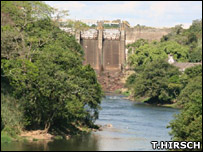|
By Tim Hirsch |

Dam impacts on greenhouse emissions are a contentious issue
|
The team at the country's National Space Research Institute (INPE) is developing prototype equipment designed to stop the greenhouse gas from entering the atmosphere.
The technology will extract the methane from the water to supplement the energy produced by the dam turbines.
The scientists estimate that worldwide the technique could prevent emissions equivalent to more than the total annual burning of fossil fuels in the UK - and reduce the pressure to build new dams in sensitive areas such as the Amazon.
|
"
We cannot hide from this problem; you have to address it
"
Fernando Ramos, INPE
|
Critics of the industry have claimed that in tropical areas of Brazil - which supplies more than 90% of its electricity from large dams - some reservoirs emit so much methane that their contribution to climate change is greater than an equivalent power station burning fossil fuels like coal or gas.
'Soda' factor
Methane is produced mainly by bacteria that break down organic matter where there is little or no oxygen, for example at the bottom of lakes and reservoirs.
Since intake pipes for hydroelectric turbines tend to be placed quite deep, methane-rich water is suddenly transferred from conditions of high-pressure to the open air.
The lead scientist of the INPE project, Fernando Ramos, told the BBC's Science In Action programme: "It's like opening a bottle of soda. A large part of the methane is dissolved in the water bubbles, and it's released to the atmosphere.
"That's the reason big hydro-electric dams built in tropical areas are harmful to the environment."
There is still great uncertainty about the precise amount of methane added to the atmosphere in this way, as each dam behaves in very different ways depending on the amount of vegetation in the water, the temperature, the shape of the reservoir and many other factors.
However, a statistical analysis carried out by the INPE scientists has estimated that large dams could be responsible for worldwide annual emissions equivalent to some 800 million tonnes of carbon dioxide.
To put that in perspective, last year's total greenhouse gas emissions from the UK were around 660 million tonnes.
Partial waters
The impact of methane emissions is disproportionate to their actual quantity, since, tonne for tonne, the gas is estimated to be more than 20 times as powerful than CO2 in creating the human-induced greenhouse effect linked to climate change.
The INPE scientists are proposing that with relatively simple technology, this unwanted by-product of hydro-electric power generation could be turned into an extra source of clean, renewable electricity.
They have estimated that some dams with an especially heavy methane load in the Amazon could increase their output by up to 50%.
The first stage of the plan is to prevent deep, methane-rich water from going directly into the turbines, reducing the "soda bottle" effect.
A submerged membrane or steel barrier close to the dam would channel surface water to the intake pipes - there is little or no methane at the higher level of a reservoir where oxygen is plentiful.
To tap the methane, a floating device would pump deep water to an enclosed rotor on the surface. This would create small droplets that would liberate the dissolved gas, which could then be piped to a plant that would burn it to produce electricity.
Technology demonstrator
Burning methane does produce carbon dioxide, but since this carbon would have originally been taken out of the air by plants through photosynthesis before being locked into the sediments on the floor of the reservoir, the scientists argue there would be no net addition of greenhouse gases to the atmosphere.
It would also prevent the much stronger global warming impacts of direct methane emissions, they say.
But the process of extracting the methane would require considerable amounts of energy.
However, the team suggest this could be supplied by hydro-power at night when demand is much lower; and in any case, they say, it would be far outweighed by the power generated by the thermal plant.
INPE hopes to develop prototype equipment to demonstrate the process later this year.
It is sure to be very controversial in Brazil where power companies have been strongly disputing claims that their dams are significant sources of greenhouse gases.
Dr Ramos told the BBC: "We cannot hide from this problem; you have to address it. In fact, it's better to recognise there is a problem today, and to use this methane that is there as a commodity, harvest it to produce energy.
"And most important, it will reduce the pressure for building new dams in sensitive areas like the Amazon region."
Hear more about the methane extraction project on Science In Action on the BBC World Service this Friday, 11 May, at 1130 GMT. (Check World Service schedules for alternative broadcast times)

|
To subscribe or visit go to: http://news.bbc.co.uk